Early Childhood Mathematics/Science: R-2
VerifiedAdded on 2022/12/30
|14
|2582
|4
AI Summary
This lesson plan focuses on early childhood mathematics and science for children in year 1. It includes a description of the learning context, the starting point of the children's learning, and the development of ideas in mathematics and science. The lesson plan covers topics such as understanding natural science, presenting and interpreting data, and making connections with other subjects. The learning experiences include activities such as questioning, discussing, and drawing. The assessment methods involve observing and evaluating the children's work. This lesson plan is designed to engage children in scientific and mathematical learning.
Contribute Materials
Your contribution can guide someone’s learning journey. Share your
documents today.

Early Childhood Mathematics/Science: R-2 1
EARLY CHILDHOOD MATHEMATICS/SCIENCE: R-2
Student ID Number
Module Code
Year Module Run
Assessment Title: Early Childhood Mathematics/Science: R-2
EARLY CHILDHOOD MATHEMATICS/SCIENCE: R-2
Student ID Number
Module Code
Year Module Run
Assessment Title: Early Childhood Mathematics/Science: R-2
Secure Best Marks with AI Grader
Need help grading? Try our AI Grader for instant feedback on your assignments.
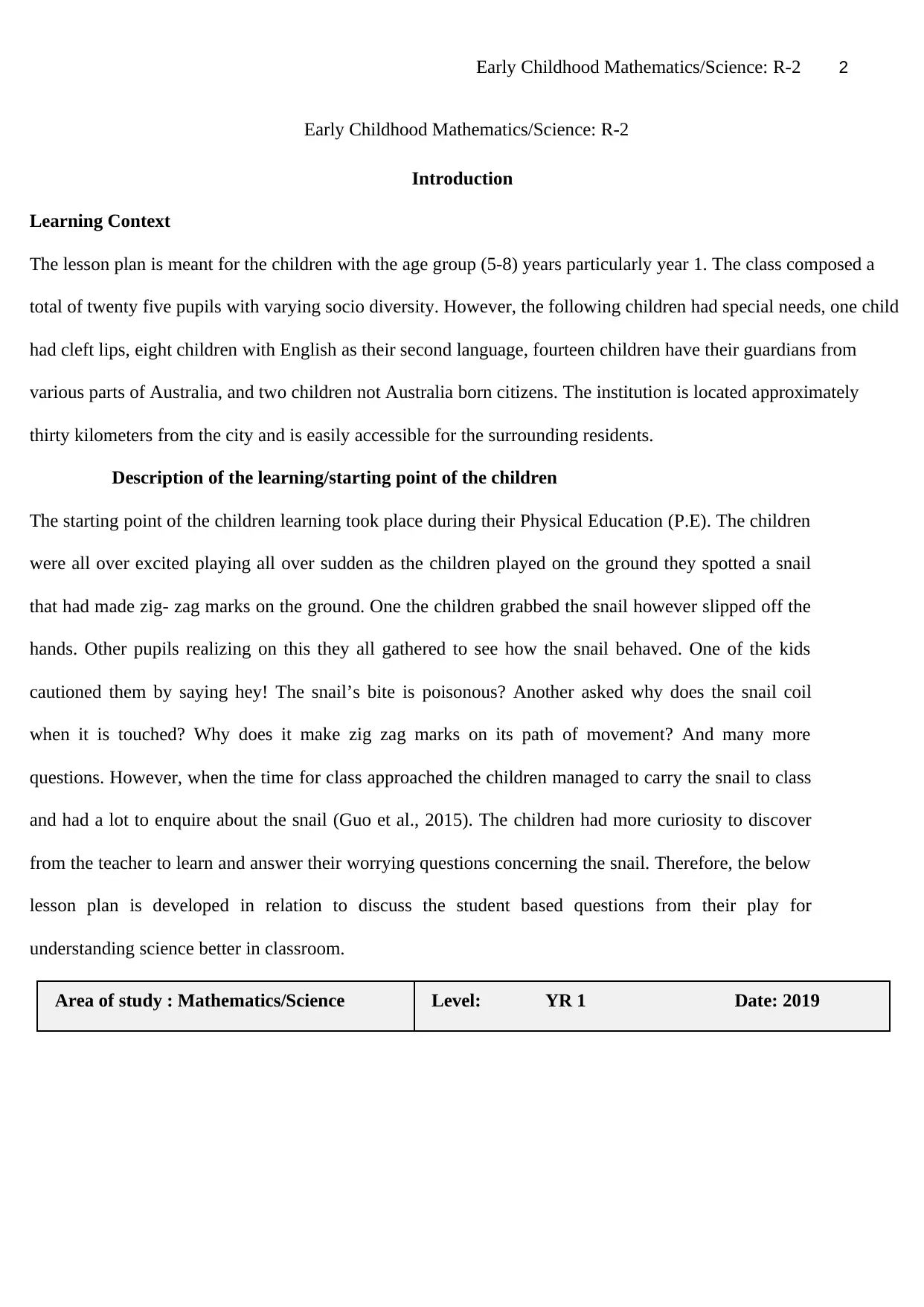
Early Childhood Mathematics/Science: R-2 2
Early Childhood Mathematics/Science: R-2
Introduction
Learning Context
The lesson plan is meant for the children with the age group (5-8) years particularly year 1. The class composed a
total of twenty five pupils with varying socio diversity. However, the following children had special needs, one child
had cleft lips, eight children with English as their second language, fourteen children have their guardians from
various parts of Australia, and two children not Australia born citizens. The institution is located approximately
thirty kilometers from the city and is easily accessible for the surrounding residents.
Description of the learning/starting point of the children
The starting point of the children learning took place during their Physical Education (P.E). The children
were all over excited playing all over sudden as the children played on the ground they spotted a snail
that had made zig- zag marks on the ground. One the children grabbed the snail however slipped off the
hands. Other pupils realizing on this they all gathered to see how the snail behaved. One of the kids
cautioned them by saying hey! The snail’s bite is poisonous? Another asked why does the snail coil
when it is touched? Why does it make zig zag marks on its path of movement? And many more
questions. However, when the time for class approached the children managed to carry the snail to class
and had a lot to enquire about the snail (Guo et al., 2015). The children had more curiosity to discover
from the teacher to learn and answer their worrying questions concerning the snail. Therefore, the below
lesson plan is developed in relation to discuss the student based questions from their play for
understanding science better in classroom.
Area of study : Mathematics/Science Level: YR 1 Date: 2019
Early Childhood Mathematics/Science: R-2
Introduction
Learning Context
The lesson plan is meant for the children with the age group (5-8) years particularly year 1. The class composed a
total of twenty five pupils with varying socio diversity. However, the following children had special needs, one child
had cleft lips, eight children with English as their second language, fourteen children have their guardians from
various parts of Australia, and two children not Australia born citizens. The institution is located approximately
thirty kilometers from the city and is easily accessible for the surrounding residents.
Description of the learning/starting point of the children
The starting point of the children learning took place during their Physical Education (P.E). The children
were all over excited playing all over sudden as the children played on the ground they spotted a snail
that had made zig- zag marks on the ground. One the children grabbed the snail however slipped off the
hands. Other pupils realizing on this they all gathered to see how the snail behaved. One of the kids
cautioned them by saying hey! The snail’s bite is poisonous? Another asked why does the snail coil
when it is touched? Why does it make zig zag marks on its path of movement? And many more
questions. However, when the time for class approached the children managed to carry the snail to class
and had a lot to enquire about the snail (Guo et al., 2015). The children had more curiosity to discover
from the teacher to learn and answer their worrying questions concerning the snail. Therefore, the below
lesson plan is developed in relation to discuss the student based questions from their play for
understanding science better in classroom.
Area of study : Mathematics/Science Level: YR 1 Date: 2019
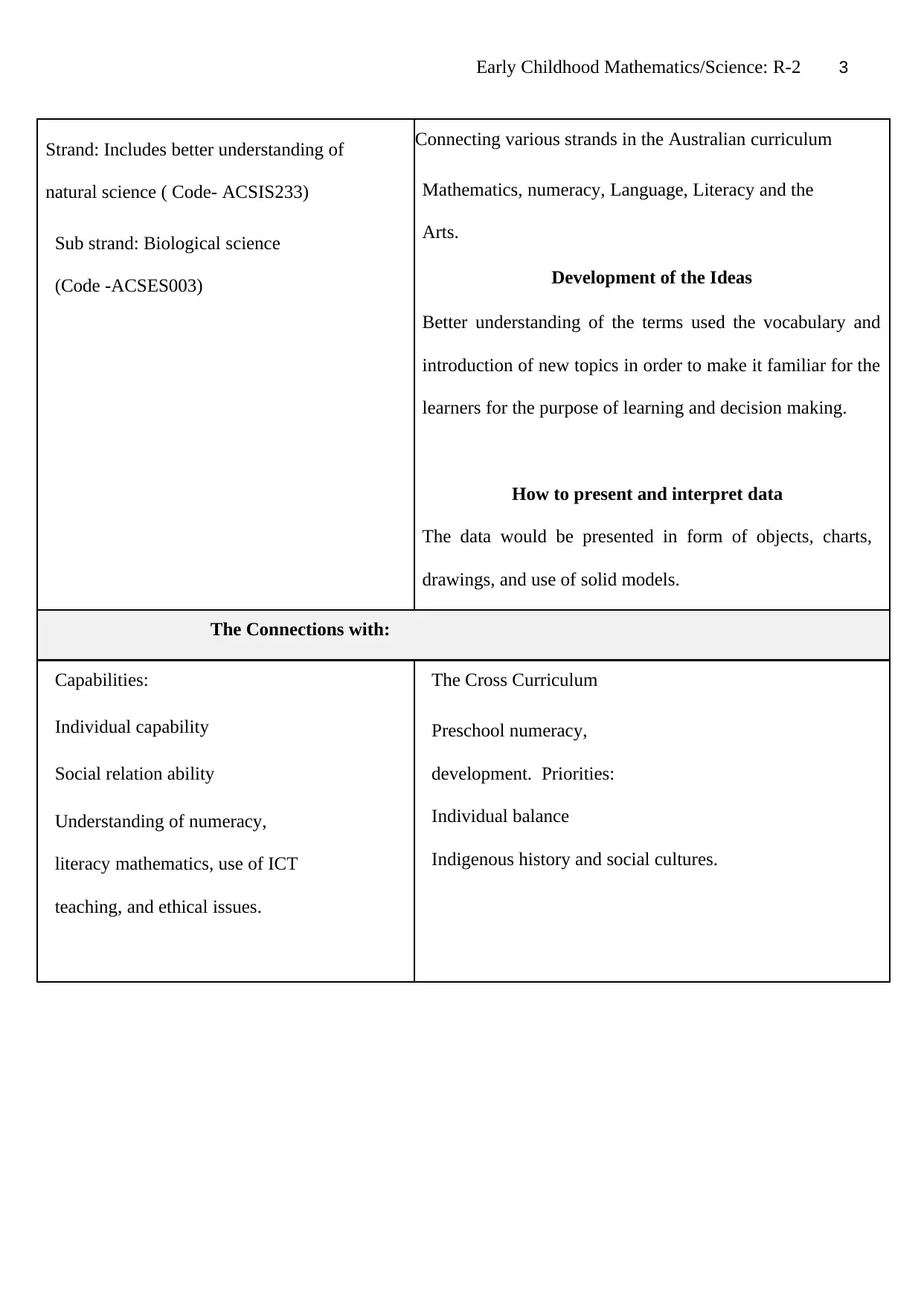
Early Childhood Mathematics/Science: R-2 3
Strand: Includes better understanding of
natural science ( Code- ACSIS233)
Sub strand: Biological science
(Code -ACSES003)
Connecting various strands in the Australian curriculum
Mathematics, numeracy, Language, Literacy and the
Arts.
Development of the Ideas
Better understanding of the terms used the vocabulary and
introduction of new topics in order to make it familiar for the
learners for the purpose of learning and decision making.
How to present and interpret data
The data would be presented in form of objects, charts,
drawings, and use of solid models.
The Connections with:
Capabilities:
Individual capability
Social relation ability
Understanding of numeracy,
literacy mathematics, use of ICT
teaching, and ethical issues.
The Cross Curriculum
Preschool numeracy,
development. Priorities:
Individual balance
Indigenous history and social cultures.
Strand: Includes better understanding of
natural science ( Code- ACSIS233)
Sub strand: Biological science
(Code -ACSES003)
Connecting various strands in the Australian curriculum
Mathematics, numeracy, Language, Literacy and the
Arts.
Development of the Ideas
Better understanding of the terms used the vocabulary and
introduction of new topics in order to make it familiar for the
learners for the purpose of learning and decision making.
How to present and interpret data
The data would be presented in form of objects, charts,
drawings, and use of solid models.
The Connections with:
Capabilities:
Individual capability
Social relation ability
Understanding of numeracy,
literacy mathematics, use of ICT
teaching, and ethical issues.
The Cross Curriculum
Preschool numeracy,
development. Priorities:
Individual balance
Indigenous history and social cultures.
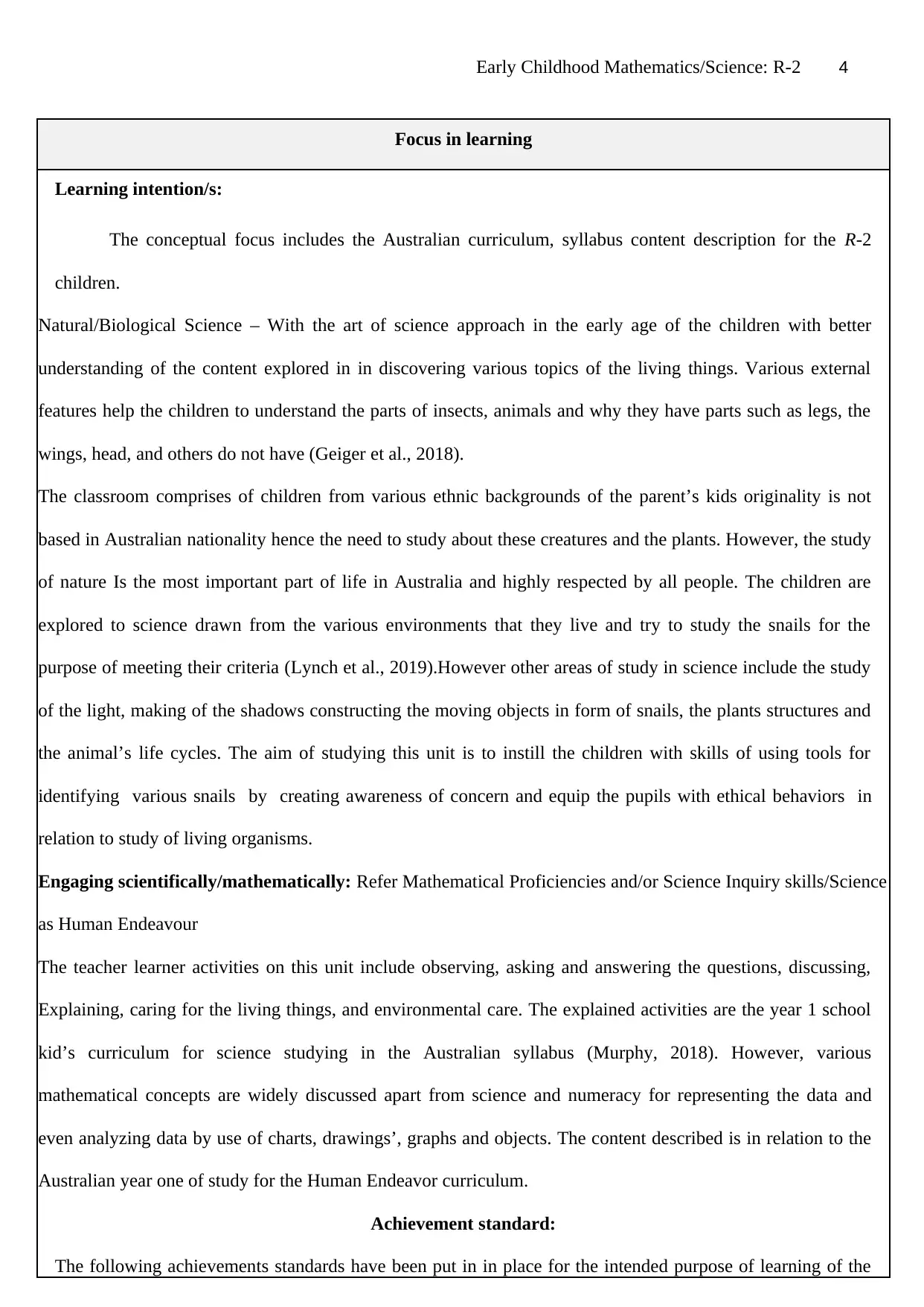
Early Childhood Mathematics/Science: R-2 4
Focus in learning
Learning intention/s:
The conceptual focus includes the Australian curriculum, syllabus content description for the R-2
children.
Natural/Biological Science – With the art of science approach in the early age of the children with better
understanding of the content explored in in discovering various topics of the living things. Various external
features help the children to understand the parts of insects, animals and why they have parts such as legs, the
wings, head, and others do not have (Geiger et al., 2018).
The classroom comprises of children from various ethnic backgrounds of the parent’s kids originality is not
based in Australian nationality hence the need to study about these creatures and the plants. However, the study
of nature Is the most important part of life in Australia and highly respected by all people. The children are
explored to science drawn from the various environments that they live and try to study the snails for the
purpose of meeting their criteria (Lynch et al., 2019).However other areas of study in science include the study
of the light, making of the shadows constructing the moving objects in form of snails, the plants structures and
the animal’s life cycles. The aim of studying this unit is to instill the children with skills of using tools for
identifying various snails by creating awareness of concern and equip the pupils with ethical behaviors in
relation to study of living organisms.
Engaging scientifically/mathematically: Refer Mathematical Proficiencies and/or Science Inquiry skills/Science
as Human Endeavour
The teacher learner activities on this unit include observing, asking and answering the questions, discussing,
Explaining, caring for the living things, and environmental care. The explained activities are the year 1 school
kid’s curriculum for science studying in the Australian syllabus (Murphy, 2018). However, various
mathematical concepts are widely discussed apart from science and numeracy for representing the data and
even analyzing data by use of charts, drawings’, graphs and objects. The content described is in relation to the
Australian year one of study for the Human Endeavor curriculum.
Achievement standard:
The following achievements standards have been put in in place for the intended purpose of learning of the
Focus in learning
Learning intention/s:
The conceptual focus includes the Australian curriculum, syllabus content description for the R-2
children.
Natural/Biological Science – With the art of science approach in the early age of the children with better
understanding of the content explored in in discovering various topics of the living things. Various external
features help the children to understand the parts of insects, animals and why they have parts such as legs, the
wings, head, and others do not have (Geiger et al., 2018).
The classroom comprises of children from various ethnic backgrounds of the parent’s kids originality is not
based in Australian nationality hence the need to study about these creatures and the plants. However, the study
of nature Is the most important part of life in Australia and highly respected by all people. The children are
explored to science drawn from the various environments that they live and try to study the snails for the
purpose of meeting their criteria (Lynch et al., 2019).However other areas of study in science include the study
of the light, making of the shadows constructing the moving objects in form of snails, the plants structures and
the animal’s life cycles. The aim of studying this unit is to instill the children with skills of using tools for
identifying various snails by creating awareness of concern and equip the pupils with ethical behaviors in
relation to study of living organisms.
Engaging scientifically/mathematically: Refer Mathematical Proficiencies and/or Science Inquiry skills/Science
as Human Endeavour
The teacher learner activities on this unit include observing, asking and answering the questions, discussing,
Explaining, caring for the living things, and environmental care. The explained activities are the year 1 school
kid’s curriculum for science studying in the Australian syllabus (Murphy, 2018). However, various
mathematical concepts are widely discussed apart from science and numeracy for representing the data and
even analyzing data by use of charts, drawings’, graphs and objects. The content described is in relation to the
Australian year one of study for the Human Endeavor curriculum.
Achievement standard:
The following achievements standards have been put in in place for the intended purpose of learning of the
Secure Best Marks with AI Grader
Need help grading? Try our AI Grader for instant feedback on your assignments.

Early Childhood Mathematics/Science: R-2 5
students in science and numeracy.
Therefore, these standard aspects includes: YEAR 1
In the first year the students are expected to demonstrate the achievements in describing the objects, and
account for varying life events such as asking the questions. The children should show the ability to
participate in the discussions and responding to the questions in relation to the everyday phenomenon
happenings. The pupils should also show the ability of following the instructions given so that they make
proper recording and observations and be able to share the knowledge /content with others (Nicholus et al.,
2015).
The plan for this unit is to make the pupils discover by themselves the nature of the surrounding and make
investigations by the assistance of the provided tools for study. The children are expected to show the
knowledge and ability of recordings what they have seen in the environment. Making of the observations
concerning the snail, how they look, and be able to share their work done in various groups. The children
should also draw the snails in their drawing books with others and display their self-reflection and reliance in
the learning. In general the children should be able to describe various events discussed in the unit for giving
them a better understanding of various terms and vocabulary used in the unit and be able to show the data
collected from the study (Wolfe, 2019).
students in science and numeracy.
Therefore, these standard aspects includes: YEAR 1
In the first year the students are expected to demonstrate the achievements in describing the objects, and
account for varying life events such as asking the questions. The children should show the ability to
participate in the discussions and responding to the questions in relation to the everyday phenomenon
happenings. The pupils should also show the ability of following the instructions given so that they make
proper recording and observations and be able to share the knowledge /content with others (Nicholus et al.,
2015).
The plan for this unit is to make the pupils discover by themselves the nature of the surrounding and make
investigations by the assistance of the provided tools for study. The children are expected to show the
knowledge and ability of recordings what they have seen in the environment. Making of the observations
concerning the snail, how they look, and be able to share their work done in various groups. The children
should also draw the snails in their drawing books with others and display their self-reflection and reliance in
the learning. In general the children should be able to describe various events discussed in the unit for giving
them a better understanding of various terms and vocabulary used in the unit and be able to show the data
collected from the study (Wolfe, 2019).
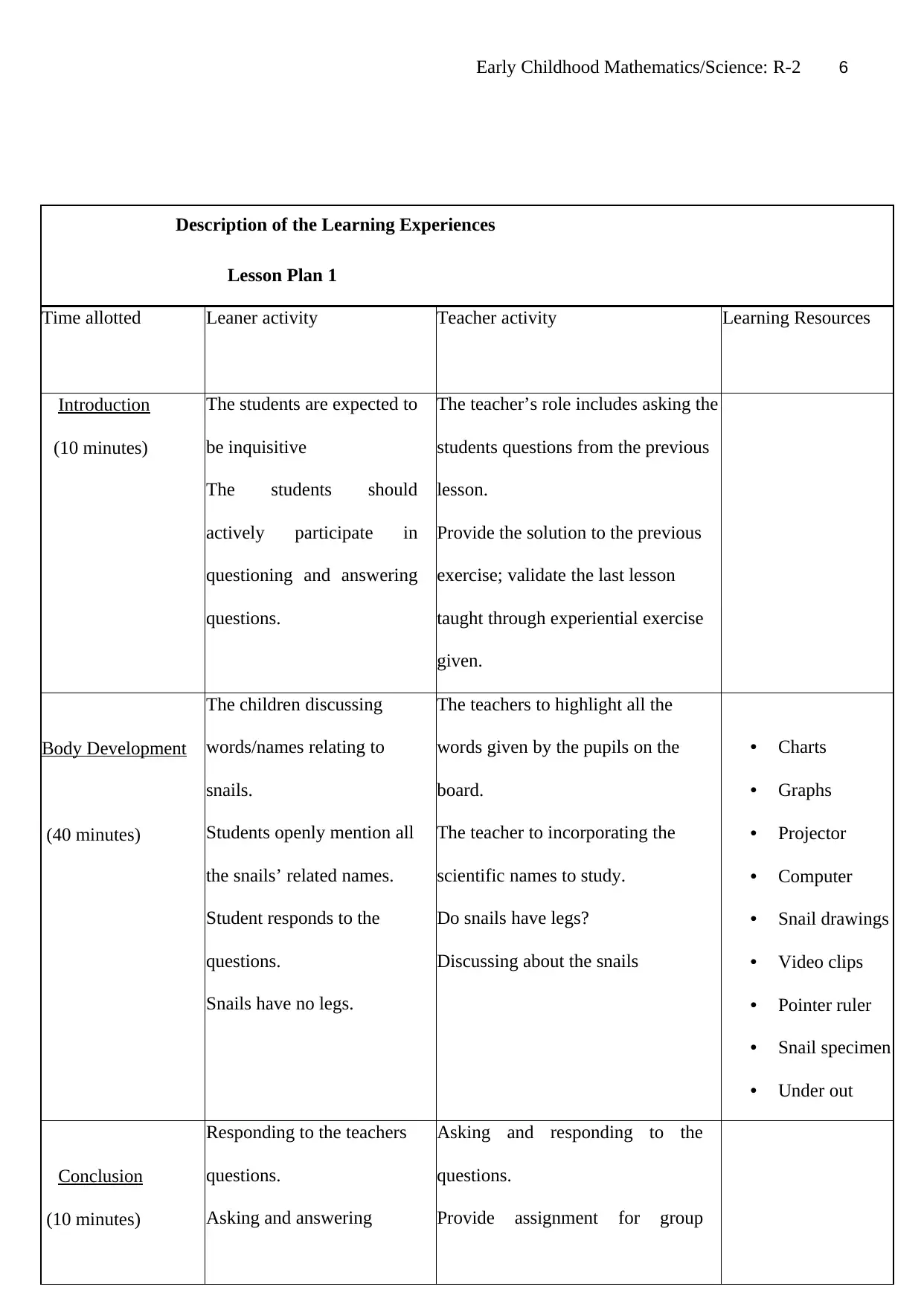
Early Childhood Mathematics/Science: R-2 6
Description of the Learning Experiences
Lesson Plan 1
Time allotted Leaner activity Teacher activity Learning Resources
Introduction
(10 minutes)
The students are expected to
be inquisitive
The students should
actively participate in
questioning and answering
questions.
The teacher’s role includes asking the
students questions from the previous
lesson.
Provide the solution to the previous
exercise; validate the last lesson
taught through experiential exercise
given.
Body Development
(40 minutes)
The children discussing
words/names relating to
snails.
Students openly mention all
the snails’ related names.
Student responds to the
questions.
Snails have no legs.
The teachers to highlight all the
words given by the pupils on the
board.
The teacher to incorporating the
scientific names to study.
Do snails have legs?
Discussing about the snails
• Charts
• Graphs
• Projector
• Computer
• Snail drawings
• Video clips
• Pointer ruler
• Snail specimen
• Under out
Conclusion
(10 minutes)
Responding to the teachers
questions.
Asking and answering
Asking and responding to the
questions.
Provide assignment for group
Description of the Learning Experiences
Lesson Plan 1
Time allotted Leaner activity Teacher activity Learning Resources
Introduction
(10 minutes)
The students are expected to
be inquisitive
The students should
actively participate in
questioning and answering
questions.
The teacher’s role includes asking the
students questions from the previous
lesson.
Provide the solution to the previous
exercise; validate the last lesson
taught through experiential exercise
given.
Body Development
(40 minutes)
The children discussing
words/names relating to
snails.
Students openly mention all
the snails’ related names.
Student responds to the
questions.
Snails have no legs.
The teachers to highlight all the
words given by the pupils on the
board.
The teacher to incorporating the
scientific names to study.
Do snails have legs?
Discussing about the snails
• Charts
• Graphs
• Projector
• Computer
• Snail drawings
• Video clips
• Pointer ruler
• Snail specimen
• Under out
Conclusion
(10 minutes)
Responding to the teachers
questions.
Asking and answering
Asking and responding to the
questions.
Provide assignment for group
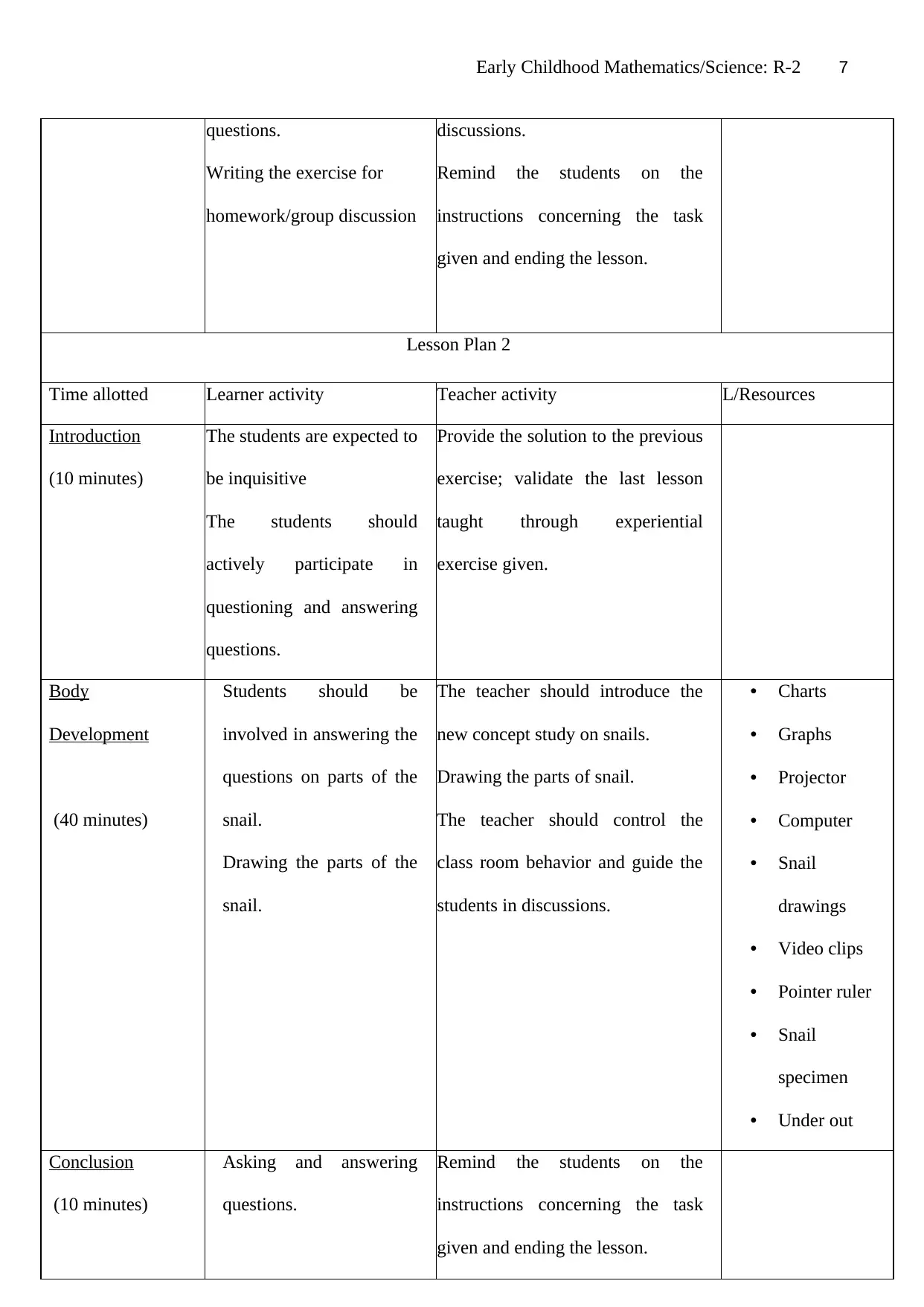
Early Childhood Mathematics/Science: R-2 7
questions.
Writing the exercise for
homework/group discussion
discussions.
Remind the students on the
instructions concerning the task
given and ending the lesson.
Lesson Plan 2
Time allotted Learner activity Teacher activity L/Resources
Introduction
(10 minutes)
The students are expected to
be inquisitive
The students should
actively participate in
questioning and answering
questions.
Provide the solution to the previous
exercise; validate the last lesson
taught through experiential
exercise given.
Body
Development
(40 minutes)
Students should be
involved in answering the
questions on parts of the
snail.
Drawing the parts of the
snail.
The teacher should introduce the
new concept study on snails.
Drawing the parts of snail.
The teacher should control the
class room behavior and guide the
students in discussions.
• Charts
• Graphs
• Projector
• Computer
• Snail
drawings
• Video clips
• Pointer ruler
• Snail
specimen
• Under out
Conclusion
(10 minutes)
Asking and answering
questions.
Remind the students on the
instructions concerning the task
given and ending the lesson.
questions.
Writing the exercise for
homework/group discussion
discussions.
Remind the students on the
instructions concerning the task
given and ending the lesson.
Lesson Plan 2
Time allotted Learner activity Teacher activity L/Resources
Introduction
(10 minutes)
The students are expected to
be inquisitive
The students should
actively participate in
questioning and answering
questions.
Provide the solution to the previous
exercise; validate the last lesson
taught through experiential
exercise given.
Body
Development
(40 minutes)
Students should be
involved in answering the
questions on parts of the
snail.
Drawing the parts of the
snail.
The teacher should introduce the
new concept study on snails.
Drawing the parts of snail.
The teacher should control the
class room behavior and guide the
students in discussions.
• Charts
• Graphs
• Projector
• Computer
• Snail
drawings
• Video clips
• Pointer ruler
• Snail
specimen
• Under out
Conclusion
(10 minutes)
Asking and answering
questions.
Remind the students on the
instructions concerning the task
given and ending the lesson.
Paraphrase This Document
Need a fresh take? Get an instant paraphrase of this document with our AI Paraphraser
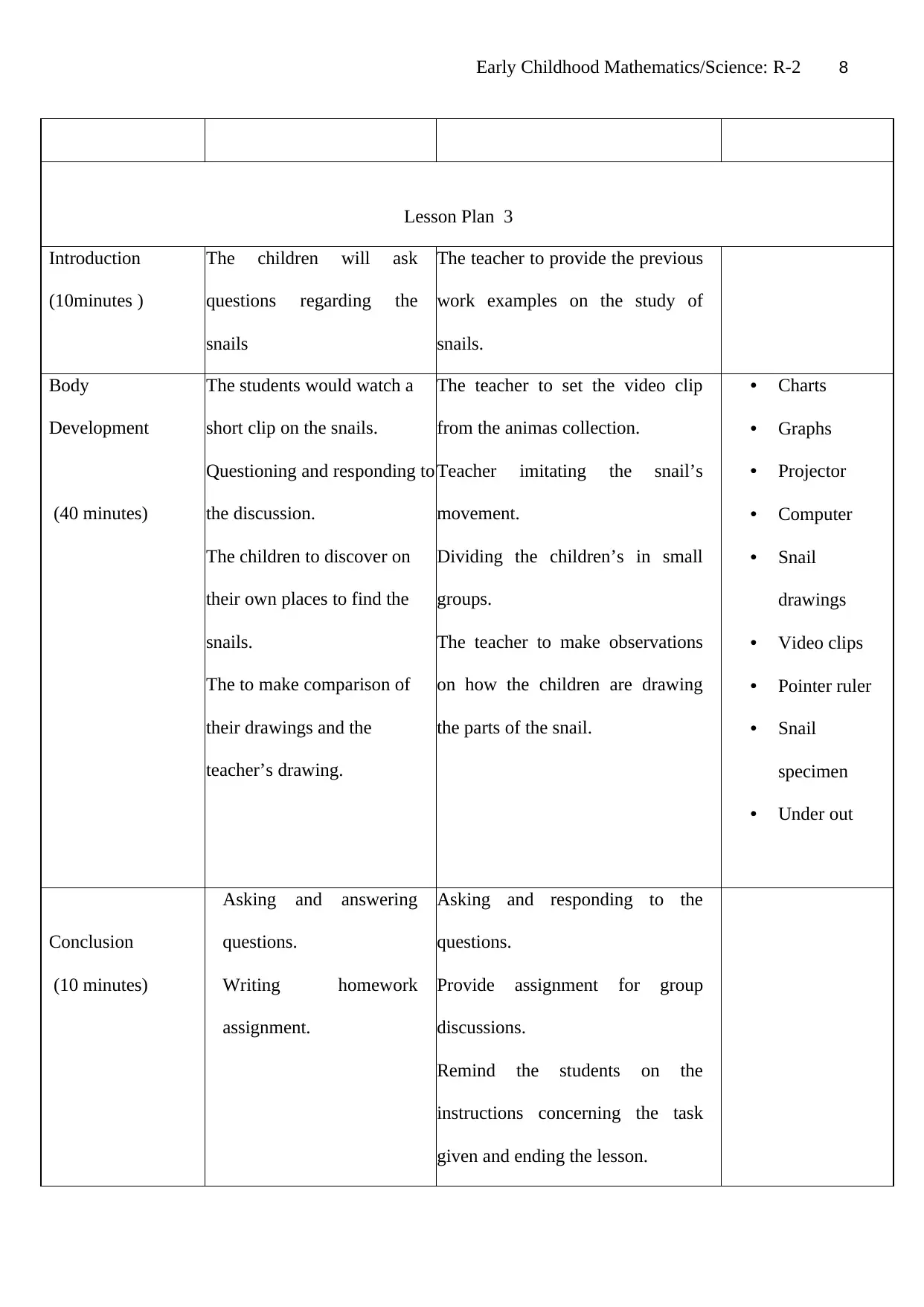
Early Childhood Mathematics/Science: R-2 8
Lesson Plan 3
Introduction
(10minutes )
The children will ask
questions regarding the
snails
The teacher to provide the previous
work examples on the study of
snails.
Body
Development
(40 minutes)
The students would watch a
short clip on the snails.
Questioning and responding to
the discussion.
The children to discover on
their own places to find the
snails.
The to make comparison of
their drawings and the
teacher’s drawing.
The teacher to set the video clip
from the animas collection.
Teacher imitating the snail’s
movement.
Dividing the children’s in small
groups.
The teacher to make observations
on how the children are drawing
the parts of the snail.
• Charts
• Graphs
• Projector
• Computer
• Snail
drawings
• Video clips
• Pointer ruler
• Snail
specimen
• Under out
Conclusion
(10 minutes)
Asking and answering
questions.
Writing homework
assignment.
Asking and responding to the
questions.
Provide assignment for group
discussions.
Remind the students on the
instructions concerning the task
given and ending the lesson.
Lesson Plan 3
Introduction
(10minutes )
The children will ask
questions regarding the
snails
The teacher to provide the previous
work examples on the study of
snails.
Body
Development
(40 minutes)
The students would watch a
short clip on the snails.
Questioning and responding to
the discussion.
The children to discover on
their own places to find the
snails.
The to make comparison of
their drawings and the
teacher’s drawing.
The teacher to set the video clip
from the animas collection.
Teacher imitating the snail’s
movement.
Dividing the children’s in small
groups.
The teacher to make observations
on how the children are drawing
the parts of the snail.
• Charts
• Graphs
• Projector
• Computer
• Snail
drawings
• Video clips
• Pointer ruler
• Snail
specimen
• Under out
Conclusion
(10 minutes)
Asking and answering
questions.
Writing homework
assignment.
Asking and responding to the
questions.
Provide assignment for group
discussions.
Remind the students on the
instructions concerning the task
given and ending the lesson.
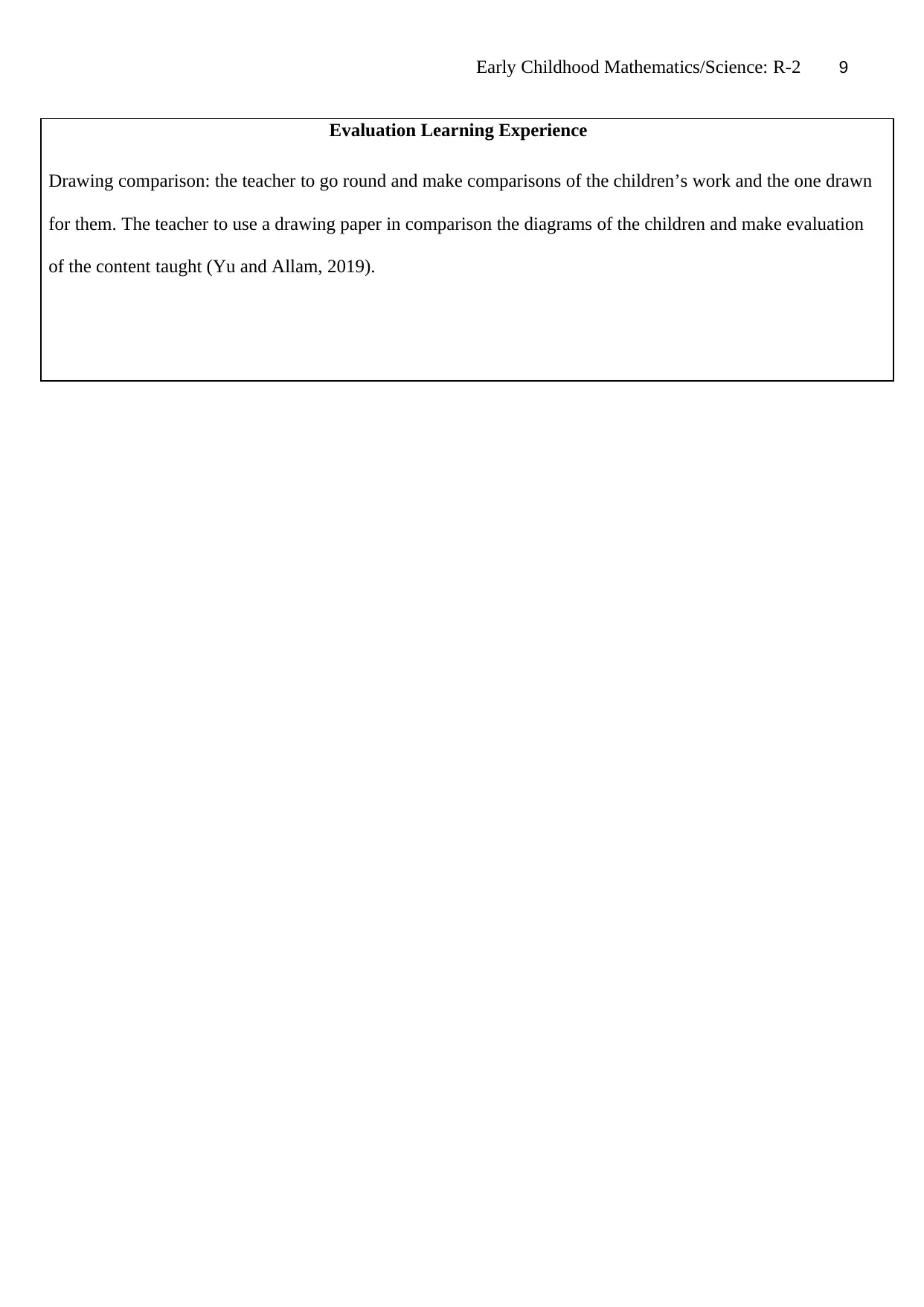
Early Childhood Mathematics/Science: R-2 9
Evaluation Learning Experience
Drawing comparison: the teacher to go round and make comparisons of the children’s work and the one drawn
for them. The teacher to use a drawing paper in comparison the diagrams of the children and make evaluation
of the content taught (Yu and Allam, 2019).
Evaluation Learning Experience
Drawing comparison: the teacher to go round and make comparisons of the children’s work and the one drawn
for them. The teacher to use a drawing paper in comparison the diagrams of the children and make evaluation
of the content taught (Yu and Allam, 2019).
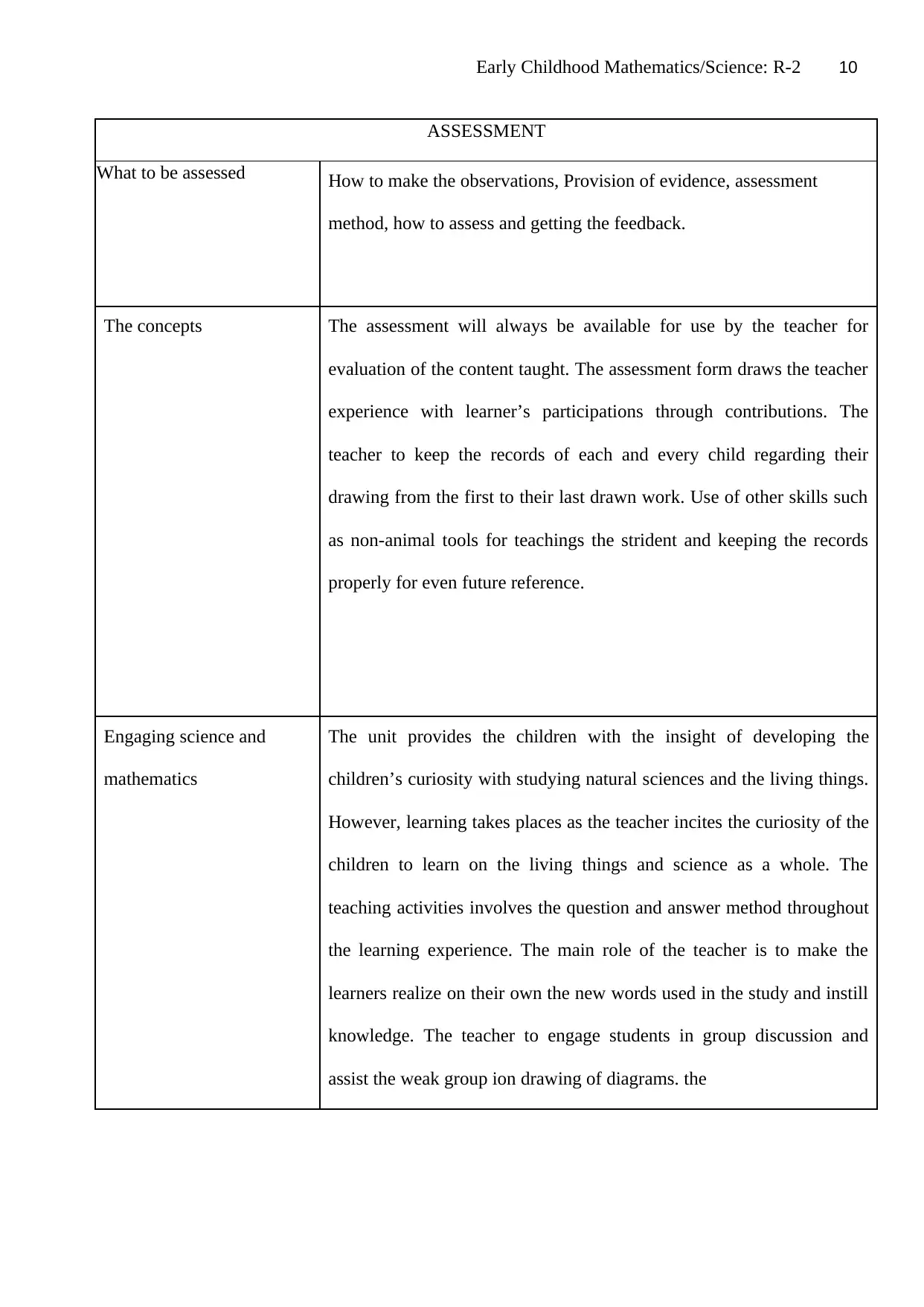
Early Childhood Mathematics/Science: R-2 10
ASSESSMENT
What to be assessed How to make the observations, Provision of evidence, assessment
method, how to assess and getting the feedback.
The concepts The assessment will always be available for use by the teacher for
evaluation of the content taught. The assessment form draws the teacher
experience with learner’s participations through contributions. The
teacher to keep the records of each and every child regarding their
drawing from the first to their last drawn work. Use of other skills such
as non-animal tools for teachings the strident and keeping the records
properly for even future reference.
Engaging science and
mathematics
The unit provides the children with the insight of developing the
children’s curiosity with studying natural sciences and the living things.
However, learning takes places as the teacher incites the curiosity of the
children to learn on the living things and science as a whole. The
teaching activities involves the question and answer method throughout
the learning experience. The main role of the teacher is to make the
learners realize on their own the new words used in the study and instill
knowledge. The teacher to engage students in group discussion and
assist the weak group ion drawing of diagrams. the
ASSESSMENT
What to be assessed How to make the observations, Provision of evidence, assessment
method, how to assess and getting the feedback.
The concepts The assessment will always be available for use by the teacher for
evaluation of the content taught. The assessment form draws the teacher
experience with learner’s participations through contributions. The
teacher to keep the records of each and every child regarding their
drawing from the first to their last drawn work. Use of other skills such
as non-animal tools for teachings the strident and keeping the records
properly for even future reference.
Engaging science and
mathematics
The unit provides the children with the insight of developing the
children’s curiosity with studying natural sciences and the living things.
However, learning takes places as the teacher incites the curiosity of the
children to learn on the living things and science as a whole. The
teaching activities involves the question and answer method throughout
the learning experience. The main role of the teacher is to make the
learners realize on their own the new words used in the study and instill
knowledge. The teacher to engage students in group discussion and
assist the weak group ion drawing of diagrams. the
Secure Best Marks with AI Grader
Need help grading? Try our AI Grader for instant feedback on your assignments.

Early Childhood Mathematics/Science: R-2 11
Differentiation:
The children’s level of thinking include: engaging the children’s in the class activities without
divesting their learning background. However, the learning activities in this unit do not involve
much with the communications skills (Anderton, and Chivers 2016). For the children whose first
language ids not English to be involved in learning new terms and use of the teacher assistance in
learning. The children learn about the snails and come up with the ways observing the real snails and
drawing theme diagrams (Larjin and Jorgenson, 2016).
Teaching Resources
General
statement The habitat Appearnce/Look
Diet The behavior
Differentiation:
The children’s level of thinking include: engaging the children’s in the class activities without
divesting their learning background. However, the learning activities in this unit do not involve
much with the communications skills (Anderton, and Chivers 2016). For the children whose first
language ids not English to be involved in learning new terms and use of the teacher assistance in
learning. The children learn about the snails and come up with the ways observing the real snails and
drawing theme diagrams (Larjin and Jorgenson, 2016).
Teaching Resources
General
statement The habitat Appearnce/Look
Diet The behavior
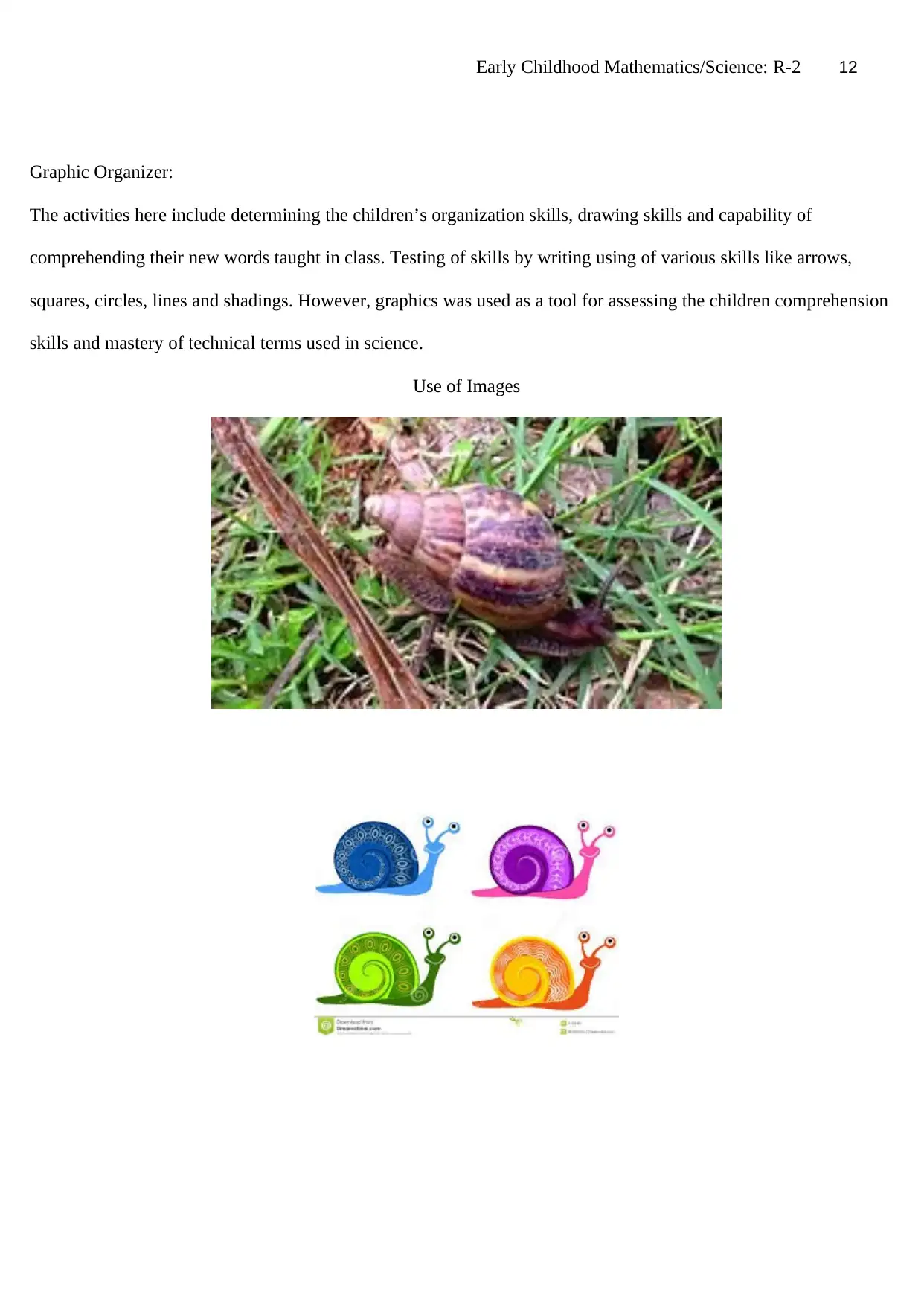
Early Childhood Mathematics/Science: R-2 12
Graphic Organizer:
The activities here include determining the children’s organization skills, drawing skills and capability of
comprehending their new words taught in class. Testing of skills by writing using of various skills like arrows,
squares, circles, lines and shadings. However, graphics was used as a tool for assessing the children comprehension
skills and mastery of technical terms used in science.
Use of Images
Graphic Organizer:
The activities here include determining the children’s organization skills, drawing skills and capability of
comprehending their new words taught in class. Testing of skills by writing using of various skills like arrows,
squares, circles, lines and shadings. However, graphics was used as a tool for assessing the children comprehension
skills and mastery of technical terms used in science.
Use of Images
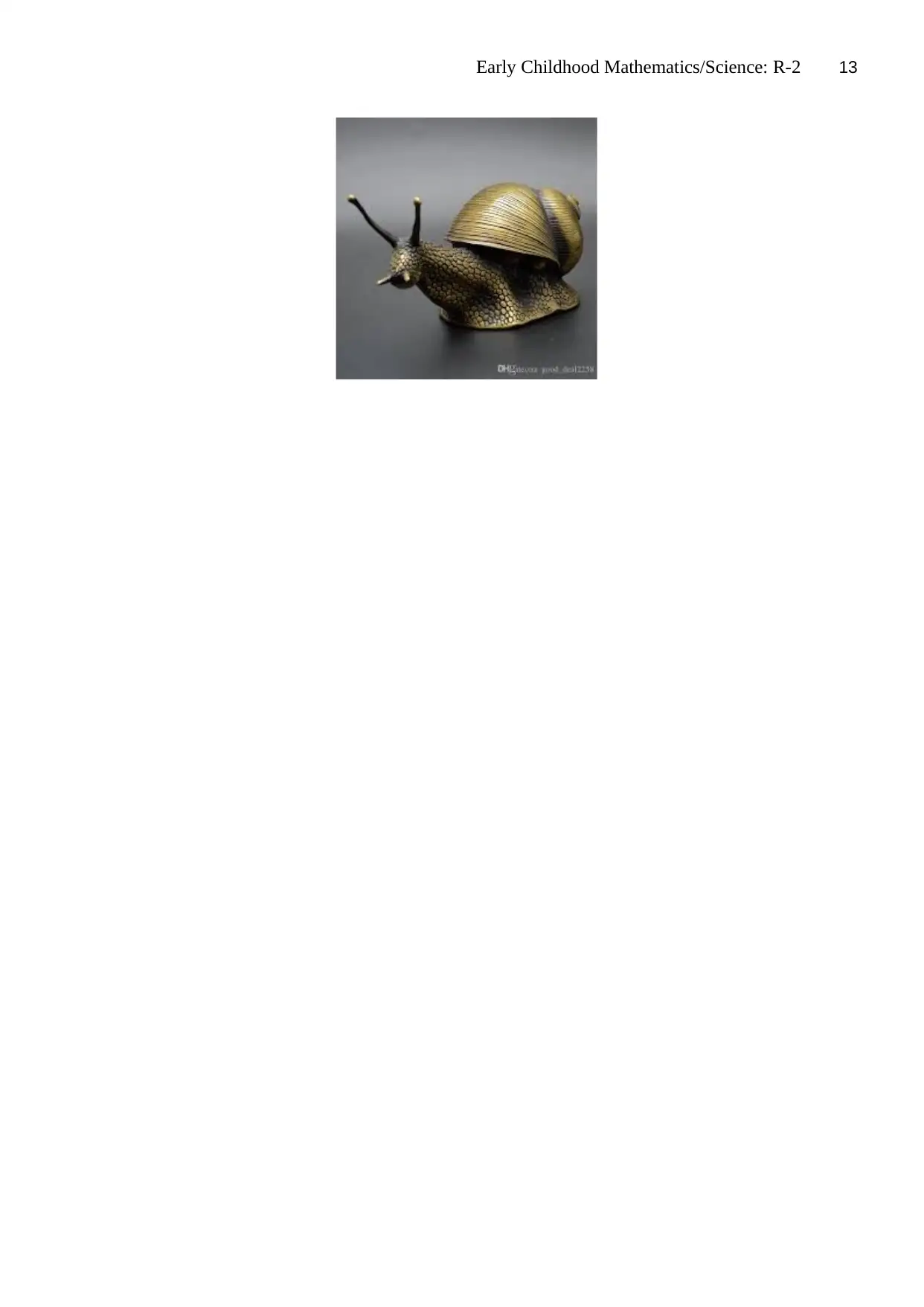
Early Childhood Mathematics/Science: R-2 13
Paraphrase This Document
Need a fresh take? Get an instant paraphrase of this document with our AI Paraphraser
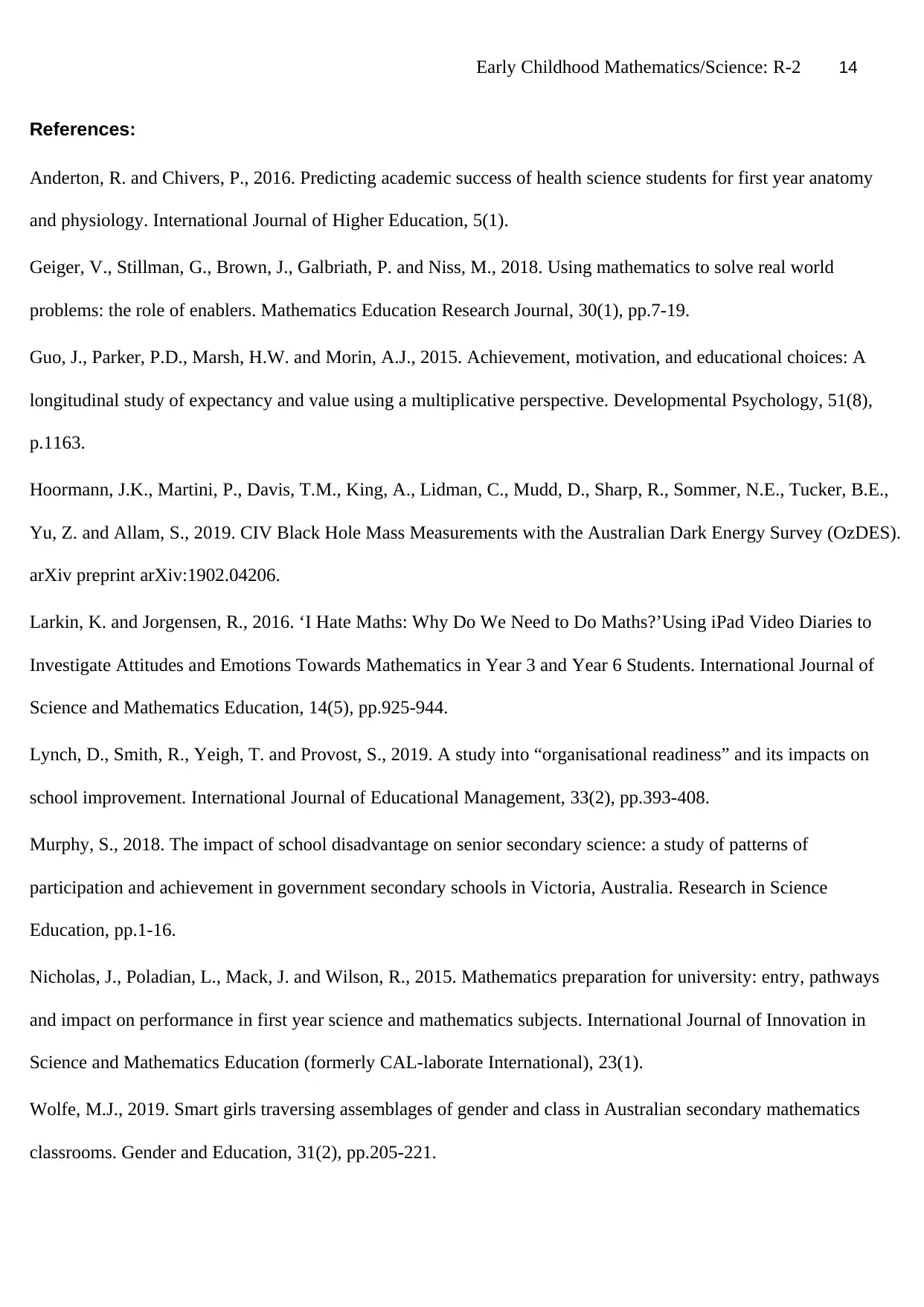
Early Childhood Mathematics/Science: R-2 14
References:
Anderton, R. and Chivers, P., 2016. Predicting academic success of health science students for first year anatomy
and physiology. International Journal of Higher Education, 5(1).
Geiger, V., Stillman, G., Brown, J., Galbriath, P. and Niss, M., 2018. Using mathematics to solve real world
problems: the role of enablers. Mathematics Education Research Journal, 30(1), pp.7-19.
Guo, J., Parker, P.D., Marsh, H.W. and Morin, A.J., 2015. Achievement, motivation, and educational choices: A
longitudinal study of expectancy and value using a multiplicative perspective. Developmental Psychology, 51(8),
p.1163.
Hoormann, J.K., Martini, P., Davis, T.M., King, A., Lidman, C., Mudd, D., Sharp, R., Sommer, N.E., Tucker, B.E.,
Yu, Z. and Allam, S., 2019. CIV Black Hole Mass Measurements with the Australian Dark Energy Survey (OzDES).
arXiv preprint arXiv:1902.04206.
Larkin, K. and Jorgensen, R., 2016. ‘I Hate Maths: Why Do We Need to Do Maths?’Using iPad Video Diaries to
Investigate Attitudes and Emotions Towards Mathematics in Year 3 and Year 6 Students. International Journal of
Science and Mathematics Education, 14(5), pp.925-944.
Lynch, D., Smith, R., Yeigh, T. and Provost, S., 2019. A study into “organisational readiness” and its impacts on
school improvement. International Journal of Educational Management, 33(2), pp.393-408.
Murphy, S., 2018. The impact of school disadvantage on senior secondary science: a study of patterns of
participation and achievement in government secondary schools in Victoria, Australia. Research in Science
Education, pp.1-16.
Nicholas, J., Poladian, L., Mack, J. and Wilson, R., 2015. Mathematics preparation for university: entry, pathways
and impact on performance in first year science and mathematics subjects. International Journal of Innovation in
Science and Mathematics Education (formerly CAL-laborate International), 23(1).
Wolfe, M.J., 2019. Smart girls traversing assemblages of gender and class in Australian secondary mathematics
classrooms. Gender and Education, 31(2), pp.205-221.
References:
Anderton, R. and Chivers, P., 2016. Predicting academic success of health science students for first year anatomy
and physiology. International Journal of Higher Education, 5(1).
Geiger, V., Stillman, G., Brown, J., Galbriath, P. and Niss, M., 2018. Using mathematics to solve real world
problems: the role of enablers. Mathematics Education Research Journal, 30(1), pp.7-19.
Guo, J., Parker, P.D., Marsh, H.W. and Morin, A.J., 2015. Achievement, motivation, and educational choices: A
longitudinal study of expectancy and value using a multiplicative perspective. Developmental Psychology, 51(8),
p.1163.
Hoormann, J.K., Martini, P., Davis, T.M., King, A., Lidman, C., Mudd, D., Sharp, R., Sommer, N.E., Tucker, B.E.,
Yu, Z. and Allam, S., 2019. CIV Black Hole Mass Measurements with the Australian Dark Energy Survey (OzDES).
arXiv preprint arXiv:1902.04206.
Larkin, K. and Jorgensen, R., 2016. ‘I Hate Maths: Why Do We Need to Do Maths?’Using iPad Video Diaries to
Investigate Attitudes and Emotions Towards Mathematics in Year 3 and Year 6 Students. International Journal of
Science and Mathematics Education, 14(5), pp.925-944.
Lynch, D., Smith, R., Yeigh, T. and Provost, S., 2019. A study into “organisational readiness” and its impacts on
school improvement. International Journal of Educational Management, 33(2), pp.393-408.
Murphy, S., 2018. The impact of school disadvantage on senior secondary science: a study of patterns of
participation and achievement in government secondary schools in Victoria, Australia. Research in Science
Education, pp.1-16.
Nicholas, J., Poladian, L., Mack, J. and Wilson, R., 2015. Mathematics preparation for university: entry, pathways
and impact on performance in first year science and mathematics subjects. International Journal of Innovation in
Science and Mathematics Education (formerly CAL-laborate International), 23(1).
Wolfe, M.J., 2019. Smart girls traversing assemblages of gender and class in Australian secondary mathematics
classrooms. Gender and Education, 31(2), pp.205-221.
1 out of 14
Your All-in-One AI-Powered Toolkit for Academic Success.
+13062052269
info@desklib.com
Available 24*7 on WhatsApp / Email
![[object Object]](/_next/static/media/star-bottom.7253800d.svg)
Unlock your academic potential
© 2024 | Zucol Services PVT LTD | All rights reserved.

